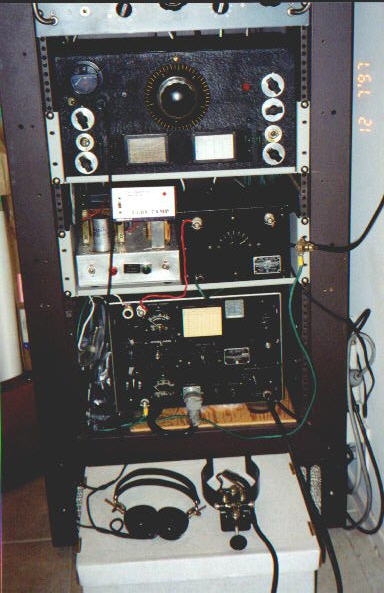160 Meter Contest 1997-QRP!

Hours and hours of CW Keying Relay Clunking...2 QSOs
THE PLAN...
Based on last years QRP experience, The plan was to wait til the West Coast QRM died down, late-night/early morning hours and call the strong stations slowly and persistantly. Well, the QRM stayed high on the West Coast, and then the Mid-West stations began to get loud and congested too. So much for the Plan.
I called the strong signals, and was encouraged by an occasional QRZ? or the most spirit raising...KH6?, but alas, no contacts from the start of the contest until about 0215 when I had to face the fact that nobody was hearing me strong enough to exchange information.
I heard many of the same stations all evening...The non-stop contesters up the coast at KH7R.. and a few others around the Hawaiian Islands. I also heard many "6s" & "7s" that after a while I could recognize their keyers and the sound of their signals. The occasional "5s", "0s", and the few "8s" and a "9" or two. Less "4s", and I am not sure that I heard a "3", "2" or "1". Only a few Canadian Stations, VE7, VE5 and I thought I heard the Yukon for a brief time. I called when they were loud or their "CQs" were unanswered, but the conditions were not good enough for my 5,000 milliwatts! I was asleep by 0230, the few winks I got sitting in my chair with the J-37 on my leg were not very restfull.
The XYL asked when I finally came to bed, I told her around midnight...then when I told her that I did not hook-up with anyone, it did not sound so bad. I told her I had a revised plan for the last night of the contest. Yes, a revised plan...hummm.....
THE REVISED PLAN....
The Collins TCS-12 Transmitter is in the bottom of a 5' extra deep rack cabinet. Above it is a steel shelf with a Homebrew AC Power Supply, and the TCS Antenna Loading Coil that is not used with the contest antenna configuration. A Butternut Multiband Vertical is coax fed with the 160 meter loading coil/capacitor assembly. The TCS is fed with a 20' piece of coax, to the auxilliary position of a coaxial switch that selects the transmitter-receiver configuration of choice. The TCS was tuned to the dummy load and output adjusted to 4.75 watts. The antenna is then fine tuned from the chart readings from last year with the MFJ 986 3 KW tuner. This tuner was chosen for its large coil and easy to operate adjustments.
The HRO-W receiver is sitting on another steel shelf, it's red jewel pilot glowing in the dark. A small lamp from the 50's nearby illuminates my note book in my lap, as I scribble calls and adjust the HRO. The HRO is very quiet, 2 stages of RF, and when compared to the R-390A mounted a few inches above, it give a great account of itself (I listened briefly to the 390a and turned it off, deciding it was much too noisey to listen too. The "Cans" were re-adjusted from time to time, Trimm Professional series, Cloth headband over spring steel, with shinny chrome at the end. Stainless steel brackets that adjust and hold the receiver elements that is just that, not the junk metal that is used in products today. I'm not sure how old these are, I have had them forever, I have older ones, but these look like the ones in the real old catalogs. I noted the readings on the plug-in coil unit. I made a chart to know where in the band the signals I am listening to are. The HRO-W was make in 1944, and has a dial read out of 0-500 that you interpolate with a chart on each of the 6 plug-in coils I have that cover the AM Broadcast Band to 30 Mc. (No Mhz in these coils)
The late night turns into morning, I fell asleep in the chair, and was awakened by the sliding notebook as it pushed the J-37 leg key off on to the floor with it. I checked the clock on the main operating desk a few feet away, it said 0213. I tried calling a few more stations.
The operation of this 1944 station is simple. You hear a station on the HRO, then look at the chart. Then, you look at the dial of the TCS-12, put it on MO TEST, and listen for the beat note from the oscillator. Next, you put it back to MO, and turn the RF gain on the RX down (Even 5 watts is loud at ground zero). I monitor the sending, pounding on my leg mounted J-37 key as it pulls the contacts of a 53-year-old relay together time after time. Me, I'm 49, and not much of me works that well. To go back to recieve, I just turn the RF gain back up and try not to hit the key... I have a switch on the HB AC Power Supply that will mute the HRO or the TCS RX(not used) on RX for "Break-in" type operation.
THE LAST FEW MINUTES...0320 Local Time (1320 UTC)
EPILOG
I may abandon QRP RF levels next year if I do not make any contacts the first night/early morning. I will go to the full 25 watt plus level of the TCS...-G
STATIONS HEARD
- 6th Call Area: N6NT, K6XX, N6RO, W6RM, KA6BIM, N6BIM, K6KB, KH7R, KH6AQ, AH6M, KH6AT
- 7th Call Area: W7CA, N7ATM, K7MI, W7CW, N7KE, W7VPK, WA7VQV, WA7ADK, KC7RA
- MISC OTHERS: KI0F, N5WS, WB9Z, W0UA, W0AH, WJ0M, AB1HZ/7, K9JF/7, K8KS, VE6SV